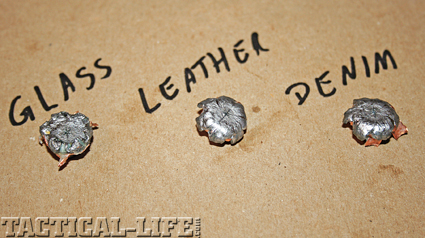“I just bought a gun for home defense. What ammo should I load in it?” That question is posed myriad times a week by shooters wanting to protect their families. It is certainly a valid inquiry, since for every caliber of handgun there are dozens of different loads to choose from. Unfortunately, much of the advice given to these shooters in based upon supposition, not fact or field-testing.
I recall browsing in a gun shop many years ago and listening to a gentleman ask the clerk what load he’d recommend for a compact .38 Special revolver. I had to cringe when the gun store clerk recommended full wadcutters as the best defensive load. His reasoning was that the broad, flat face of the wadcutter would do the most damage.
You see, in theory the store clerk was right. However, he failed to factor in the fact that wadcutter ammunition is design for match competition. This ammunition is loaded very light. All a wadcutter needs to do is get down range 15 to 25 yards and cut a perfect round hole in the target. That’s it. From a target-length barrel you can expect velocities in the 700 feet per second (fps) range; from a snub-nose you’d be looking at mid-500 fps. That’s not likely to impress the cracked out felon bent on killing you. The lightweight, soft lead bullet isn’t likely to dig deep and do any serious damage.
Advertisement — Continue Reading Below

Critical Defense
After cutting their teeth on the medium calibers of 9mm, .380 ACP and .38 Special, Hornady has expanded their line of Critical Defense ammunition. New loads include the .40 S&W and .45 ACP as well as a .357 Mag version. Critical Defense is not practice ammo, to be sure. Hornady uses nickel-plated cases for corrosion resistance, clean-burning powder with reduced muzzle flash and their specially designed projectiles.
The Critical Defense ammunition uses Hornady’s FTX bullets. These are composed of a solid lead core wrapped in a copper jacket with a deep cavity. This jacket is pre-cut for rapid expansion and there is a cannelure to keep the entire projectile together during expansion.
A distinctive red polymer plug fills the expansion cavity in the bullet. This plug helps the rounds chamber properly as there is no hard edge on the face of the projectile. When the bullet strikes its target, the red plug blocks any foreign material from entering the cavity and assists with reliable, even expansion.
Advertisement — Continue Reading Below
.45 ACP
American gun owners are very fond of their .45s and that’s a fact not likely to change anytime soon. For this review I decided to give the new .45 Critical Defense load a thorough going over. The FTX bullet for this cartridge is 185 grains and it is factory-rated for a muzzle velocity of 1,000 fps from a 5-inch test barrel.
In addition to accuracy and velocity testing, I would fire rounds through various materials that a citizen might encounter during a self-defense scenario. To test this ammunition I decided to work with an excellent new pistol from Springfield Armory, the XDM .45 ACP. The barrel length on the XDM is 4.5 inches and rated as a Match version.
The first couple of steps were simple enough. I ran a half a dozen rounds of CD .45 over my Shooting Chrony F1. The result was an average 1,003 fps. My range is basically at sea level, the temperature was 91 degrees Fahrenheit and the humidity was high. The plus/minus deviation was 30 fps.
Advertisement — Continue Reading Below
Resting my arms on a range pad, I fired another six rounds on a target 25 yards away. The best five rounds posted a group of 2.35 inches. The 185-grain projectiles stuck about three inches above point-of-aim with the XDM.























